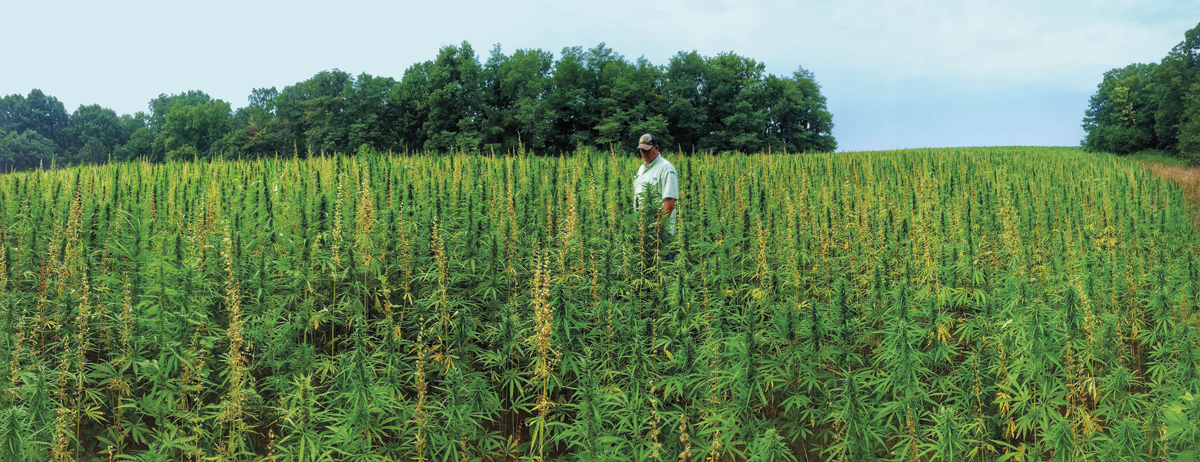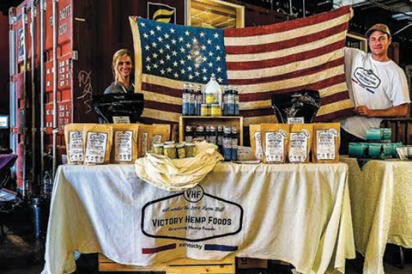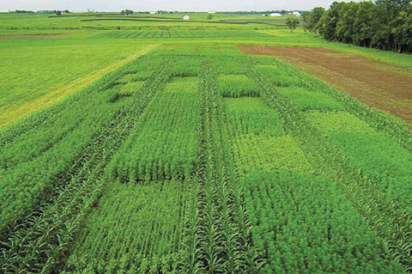Can Hemp Bring New Life to Agriculture in Kentucky?
Can what was old be new again?
Kentucky farmers looking to kick the tobacco-growing habit may soon have a new option—one that isn’t new at all. Hemp, a non-psychedelic cousin of the marijuana plant, has great promise as a source of industrial fiber, food products and medicines. Before 1937, when hemp was banned along with marijuana in a case of mistaken botanical identity, Kentucky had proven a great place to grow it. With that ban likely to soon end, it could be again. More than 240 years ago, Kentucky was a leader in hemp production, producing as much as 40,000 tons of it to make twine, rope, parachutes and bags for cot-ton picking. Like other big-volume crops of tobacco and cotton, hemp once served a vital role in the American economy. Perceptions shifted thanks to Reefer Madness, a 1930s propaganda film that confused the staple fiber crop with its “misbehaving cousin” marijuana. As a result, hemp was categorized as a Schedule1 controlled substance in 1937. The hemp party was over. Now it’s coming back.
Thanks to years of hard work by former Commissioner of Agriculture James Comer and many other Kentucky leaders, as well as the 2014 Farm Bill, progress is being made to begin re-establishing hemp as an alternative to the declining tobacco crop. With the restrictions loosening, more Kentucky farmers who formerly grew tobacco are adding hemp to their rotation. While hemp was formerly prized mainly for its fibers, these days its seeds and oil are touted as a “super-food” and showing up in an ever-increasing range of edible products. Hemp seeds can be hulled, toasted or ground and turned into a wide variety of products for human consumption, including hulled hemp hearts to add to food dishes; protein powder for cooking, baking or supplementation; oil for dressing and cooking and much more. Other uses for hemp include supplements, paper, personal care products and industrial applications like car parts and construction materials. he highest value of the plant comes from the cannabidiods (CBD) compound. Although often confused with the THC compound of the marijuana plant, CBD doesn’t produce a “high.” Nevertheless, on December 16 both compounds were classified as Schedule 1 controlled substances, a ruling likely designed to track medical studies of CBD and help regulate the increasing number of states legalizing medical marijuana.
According to U.S. government patent documents, CBD has been found to be useful in the treatment of Alzheimer’s disease, Parkinson’s disease and HIV-associated dementia, as well as aiding in the prevention inflammatory and autoimmune diseases and limiting damage from Ischemic insults, such as stroke. And certain epileptic patients treated with CBD have shown to experience fewer and less severe seizures. Other benefits include as an appetite enhancer and anti-depressant.
In January, the Kentucky Department of Agriculture approved 209 applications for growers to cultivate up to 12,800 acres of industrial hemp for research purposes during the 2017 season—triple the 2016 acreage—and more than 525,000 square feet of greenhouse space was approved for indoor growers. In addition, 11 new applications from processors were approved, and five universities will carry out additional research projects this year.
“By nearly tripling hemp acreage in 2017 and attracting more processors to the state, we are significantly growing opportunities for Kentucky farmers,” says current Agriculture Commissioner Ryan Quarles. “Our strategy is to use KDA’s research pilot program to encourage the industrial hemp industry to expand and prosper in Kentucky. Although it is not clear when Congress might act to remove industrial hemp from the list of controlled substances, my strategic objective is to position the Commonwealth’s growers and processors to ultimately prevail as national leaders in industrial hemp production.”
Winchester-based Atalo Holdings, Inc., a diversified industrial hemp research and production company, announced a $2 million payout to their Growers’ Group for the 2016 harvest, including hemp grain and CBD oil production. Dispensary sales of CBD products are expected to be $1.6 billion by 2020.
With U.S. consumers purchasing almost $600 million hemp-based products in 2015, Kentucky sees an opportunity to return to a crop that has traditionally thrived in rich Kentucky soil. And, universities are researching ways to help support the growing market for hemp products. To date, 28 states have passed legislation allowing research hemp farming, and new industry fields ranging from foods to car manufacturing are looking to American farmers to meet the growing demand for hemp.
Hemp in the marketplace
The University of Kentucky is a leader in industrial hemp research under the direction in part of agronomist David Williams, director of University of Kentucky Robinson Center for Appalachian Resource Sustainability (RCARS). The Kentucky Tobacco Research and Development Center (KTRDC) and the UK Department of Plant and Soil Sciences (PSS) are joint participants in the Kentucky Department of Agriculture’s Industrial Hemp Pilot Research Program.
One of the main goals of the program is to investigate how to maximize plant growth and harvest depending on the plant’s intended use, either as an edible grain, fiber or cannabinoid.
“It’s exciting to work with a new plant,” he said. “People in my line of work almost never get that opportunity. The interest in the crop [from political to corporate to individuals] adds to that excitement.”
But Williams, who referred to himself as an unbiased evaluator, still has a healthy dose of scientific skepticism.
“Bottom line, I think it will be an industry, but how big?” he questioned. “From my perspective, one of the main things we deal with is, it’s often indicated that hemp is some kind of an extra special plant, and really I don’t think that’s so much the case. … Hemp may be superior in some cases, but in many cases it’s not. All these other plants are fully legal to grow so they’re far less complex and complicated.”
“We have scientists working on the economics of hemp, helping farmers make educated decisions,” William said. “We’re working on biofuel productions and have several molecular biologists —all the standard stuff.” He noted that industrial hemp colleagues in the European Union and Canada have had legal hemp industries for more than two decades—especially in Europe, where the fiber is more prominent—so the United States is playing catch up.
But because Kentucky’s soil has already proven to be fertile for growing hemp, he sees hope for the state’s hemp crop to be a strong source for the fiber industry.
“Some of our historic practices of growing hemp for fiber can apply today,” Williams said. “But the grain today is different than the last go-around. Canada, where almost 100 percent of hemp is grown for food, has well defined practices, so we don’t have to reinvent the wheel.”
The challenges farmers will face with hemp is that it is a small seed compared to other commodity crops, making planting extremely important. This is especially true because of a second point: competition from weeds.
In the field, hemp doesn’t require a lot of pesticides or herbicides—which is helpful since there are no legal herbicides approved for hemp under the farm bill.
“Establishing a canopy before the weeds have a chance to destroy is extremely important,” said Williams. “It’s success or failure. Planting depth and soil moisture are extremely important. If you can meet those standards then it generally out competes most weeds.” The next question becomes whether farmers can turn a profit.
“If cannabinoids become a legal commodity, I can see possibly some small farmers having an opportunity, but it all depends on the supply-and-demand equilibrium. The price of those today at a retail level, it could potentially be profitable. And 20 acres on a small family farm could make a positive difference,” said Williams.
Grain and fiber, on the other hand, will require significant acreage to be profitable.
“It’s going to compete with corn and soybeans, so it will have to be profitable. It is today, so that’s very encouraging. So really all that matters now is what the market will be.”
He added that he’s encouraged by the current tendencies of major manufacturers to investigate natural fibers in replacement of synthetic fibers, but added that there are other fiber plants besides hemp, like kenaf that also is grown at UK.
Hemp in the Kitchen
Chad Rosen, founder of Victory Hemp Foods in Campbellsburg, sees a bright future for hemp in Kentucky, especially as a local and sustainable food source. In fact, Rosen is building a processing plant in anticipation of the increased local hemp harvest.
According to Rosen, hemp is a potential solution to a lot of the challenges facing our food system, including notable health benefits not offered in a lot of plant-based foods, and he spends a large part of his time traveling the state to educate consumers on ways to incorporate this homegrown super food into their daily diets. “Just from the food perspective, it’s undeniable that hemp’s properties are superior to other plants like flax and soy,” said Rosen. “It has more digestible protein than any other plants, the perfect balance of healthy fats, all nine essential amino acids. It stands on its own for nutrition.”
But that fact alone is not yet enough to make the crop fully legal and industrialized on a national level and still doesn’t guarantee that the market will demand it on a sustainable level.
“If you start to unpack all the potential places hemp can have an impact, there’s an enormous cross-section of where it can improve on some of our most pressing problems,” said Rosen, who was previously in the construction business in California and moved to Kentucky to explore the hemp business when the first crops were allowed to grow for research purposes in 2014.
“Agribusiness really has a few crops that commodity farmers are able to grow on mass scale and they have limited applications. We’re seeing a trend moving away from that. Hemp has so many uses; it’s a very diverse crop, so we don’t envision it being a crop that’s going to suffer the same volatility that so many crops have in the past. And it lends itself well to providing farmers with multiple streams of income from the same plant.”
“The grain can be used for a variety of incredibly healthy, nutritious food products,” Rosen said, adding that the stalk is equally as useful, applied to animal bedding, construction material, automotive manufacturing, textiles, packaging, and so much more. “It’s such a diverse plant that if we bring it into the rotation in a responsible manner it provides us with a lot of different solutions. I think the opportunity is enormous when it comes to the impact that it can have in our rural economics and our food system.”
What hemp is still not protected from, however, are the cannabis jokes. Looking so similar to its marijuana cousin, hemp still fights a lot of stigmas—despite having virtually no THC, pot’s high-inducing active ingredient —and it still brings up a lot of questions and raises eyebrows. But this is welcome for Rosen.
“I think the jokes are all well and fun, and it’s a really great ice breaker,” he said. “There’s always a joke like that, and to some degree that’s kind of a good thing. I would say that the perception is it still needs to evolve, but most people probably know it’s different. They probably don’t really understand what it is, and people really don’t know what it can be.”
The Hurdles of Hemp
All merits aside, there still is an uphill battle to be fought. Rosen noted that if hemp is fully legalized it likely will always be considered a controlled substance, “which isn’t necessarily a bad thing.”
“I thought it would be easier to raise money for the projects, but I think we have a lot of reluctance to fund hemp projects,” Rosen said. “Starting a business, which is what we’re doing, is not easy. There’s no quick, cheap, easy path. We’re doing it on a shoestring and it’s hard work, but it’s totally possible.”
The uncertainty of whether or not it will remain legal to grow for research and when or if it will be fully legal to grow is a tough pill for economic backers. And farmers are reluctant to bring it into their crop rotation because of both the legal uncertainty and the financial unknowns.
“Funding an industry like hemp, you’re doing not only food, but for fiber and medicine,” Rosen said. “For one part to work, all parts need to work. I don’t think anyone has really reached their arms around the entire equation and how it’s going to get done. But what is encouraging is the market. As soon as we got our brand together, it was pretty easy to make sales and get product on store shelves. People love it and listen to the message of what hemp is. And they like that we’re growing it here in the U.S.”
Bottom line: What the industry might lack in legality it makes up for in creativity and persistence. The hemp industry also benefits from a great sense of teamwork. Legislators, growers, processors and retailers are all working together extremely well, Rosen noted. Will hemp replace the income lost with the disappearance of tobacco and coal revenue? Time will tell. According to the increasing number of Kentucky farmers and entrepreneurs investing in it, the future looks promising.
Additional Information
Victory Hemp Foods carries hemp protein, hemp oil and “hemp hearts,” which are shelled hemp seeds. Products are available at Rainbow Blossom stores in Louisville and southern Indiana, Good Foods Co-op in Lexington, Herb and Olive in Elizabethtown, Berea Farm Store in Berea, Farm Market in La Grange, and in 2017 Whole Foods stores in Louisville and Lexington. VictoryHempFoods.com
Kentucky Department of Agriculture’s Industrial Hemp Pilot Research Program: kyagr. com/marketing/hemp-pilot.html
Kentucky Tobacco Research and Development Center (KTRDC): www2.ca.uky.edu/KTRDC/
UK Department of Plant and Soil Sciences (PSS): PSS.ca.uky.edu






